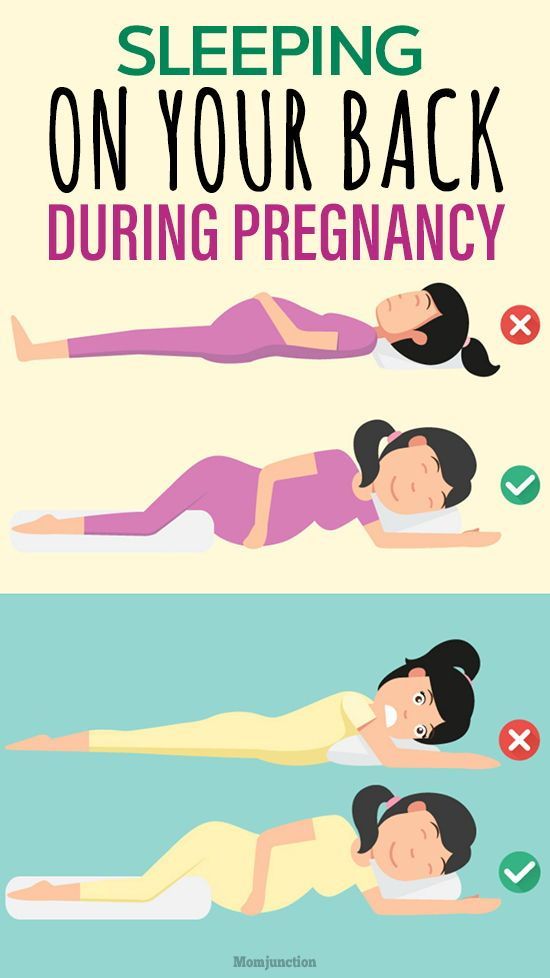Is it safe to sleep on right side while pregnant
Right Side vs. Left Side, More
From steering clear of your favorite contact sports to shunning certain foods, the do’s and don’ts list of pregnancy can be a bit overwhelming.
And as your belly grows week after week, you may be adding sleep positions to your list of concerns.
Here’s some help wading through the myths and facts related to sleep positions during pregnancy and how the way you rest affects the health of your baby and you.
Related: 11 foods and beverages to avoid during pregnancy
Doctors generally recommend sleeping on your side during pregnancy, especially as time goes on.
Why is this exactly? It boils down to blood flow. As the fetus gets bigger, there is greater chance of compression of the blood flow to the uterus.
However, doctors still continue to tilt patients when they are lying down during a cesarean delivery, commonly called a c-section, or when they are in labor with abnormal heart rhythms.
A 2019 review of medical studies suggests that sleeping on your back carries risks, but it doesn’t seem to matter whether you sleep on your right or left side.
These studies do have some flaws, though. Third trimester pregnancy loss is very uncommon. Therefore, there aren’t many cases from which to draw conclusions.
Additionally, it’s difficult to determine exactly when the fetus passed away and whether there were other factors involved. It can be challenging to pinpoint what is occurring in utero without monitoring.
The study did find, however, that there was an increased risk of stillbirth for back sleepers after 28 weeks.
There’s a lot of mixed data on whether lying flat on your back during pregnancy contributes to an increased risk of stillbirth.
A 2019 study of about 800 women for up to 30 weeks of pregnancy examined the sleeping positions of those who experienced stillbirths.
The researchers found no association between those who reported sleeping on their back or a non-left side sleeping position.
Currently, only a limited number of studies are available on this topic. More research is needed to be certain whether or not there is an association between stillbirths and sleeping positions up to 30 weeks of pregnancy.
Left side
Sleeping on your left side is often referred to as the “ideal” scenario during pregnancy.
Positioning yourself on the left side of your body allows for optimal blood flow from the inferior vena cava (IVC).
This large vein runs parallel to your spine on the right side and carries blood to your heart and, in turn, to your baby.
Sleeping on your left side also takes the pressure off your liver and your kidneys. This means more room to function properly, helping with swelling issues in your hands, ankles, and feet.
Right side
So, if the left side is ideal — should you avoid the right side? Not necessarily.
That 2019 review showed equal safety with sleeping on the left and right sides. There’s a slight risk of compression issues with the IVC when you sleep on the right, but it’s mostly a matter of where you’re comfortable.
A note about baby’s sex
You may have heard that your sleep side indicates the sex of your baby. This is just an urban legend. There are no studies to suggest that sleep position has any correlation to the sex of your baby.
This is just an urban legend. There are no studies to suggest that sleep position has any correlation to the sex of your baby.
Related: Can belly shape in pregnancy predict you’re having a boy?
If side sleeping isn’t your thing, here are some suggestions for how to make it feel more natural or at least comfortable.
If you’re especially concerned about your sleeping position, you may even ask your partner to check on you from time to time and help nudge you into a better position.
First trimester
Sleeping in any position is generally fine early on. But if you want to get into the habit of favoring your side, try simply slipping a pillow between your legs. This may ease discomfort in your hips and lower body.
And if you want to be a little, well, extra, you could consider getting an orthopedic knee pillow that’s made of memory foam.
Second trimester
As your belly grows, you’ll want to make sure your mattress is somewhat firm so your back doesn’t sag. If yours is too soft, you might consider slipping a board between your mattress and box spring.
If yours is too soft, you might consider slipping a board between your mattress and box spring.
You may also want to look into pregnancy pillows. They come in U or C shapes and wrap around your entire body to help with side sleeping.
You position the pillow so that it runs along your back and then hug the front while simultaneously slipping it between your knees.
Third trimester
Continue using a pregnancy pillow for support. If you find them a bit cumbersome with your growing belly, investigate wedge pillows. You can stick them under your belly and behind your back to keep from rolling.
If you simply can’t get used to sleeping on your side, try using pillows to prop your upper body at a 45-degree angle. This way, you’re not flat on your back and you take the compression off your IVC.
Alternatively, you can try elevating the head of your bed a couple inches with books or blocks.
Wondering if you can sleep on your stomach during pregnancy? You sure can — at least for a while.
Stomach sleeping is OK until you reach about weeks 16 to 18. At that point, your bump may be growing a bit bigger, making this position less and less desirable. It may feel a bit like you’re trying to sleep atop a watermelon.
Besides comfort, though, there isn’t much to worry about if you somehow find yourself on your stomach. The uterine walls and amniotic fluid protect your baby from being squished.
To make this position more comfortable, you may consider purchasing a stomach sleeping pillow. Some are inflatable and some are more like a firm pillow with a large cutout for your belly.
Whatever one you choose, the idea is that you get some shut-eye on your stomach while giving your baby (and you) plenty of room to breathe.
Related: How to kick insomnia in early pregnancy
Sleeping on your back is generally considered safe throughout the first trimester.
After that, you may have heard that studies link sleeping the whole night on your back to stillbirth. Before you get too worried, understand that the studies are small and there may be other factors like sleep apnea at play.
Before you get too worried, understand that the studies are small and there may be other factors like sleep apnea at play.
Nevertheless, these studies can’t be completely discounted. In the end, not sleeping on your back may lower your risk of stillbirth after 28 weeks by 5.8 percent.
Plus, there are other issues with sleeping on your back. This position may contribute to back pain, hemorrhoids, digestive issues, and poor circulation. It may also make you feel lightheaded or dizzy.
Should you worry if you wake up on your back in the middle of the night? Likely not — but it’s a good idea to try another position.
If you’re a solid sleeper (lucky you!) and often find yourself on your back, consider placing a wedge pillow behind you.
That way, when you try to roll onto your back, you’ll stop at an angle that will still allow blood to flow and nourish your baby.
Related: Your guide to sleeping on your back during pregnancy
Shop for pregnancy pillows online
- wedge pillows
- stomach sleeping pillows
- side sleeping pillows
- orthopedic knee pillows
There’s a lot you may worry about during your pregnancy.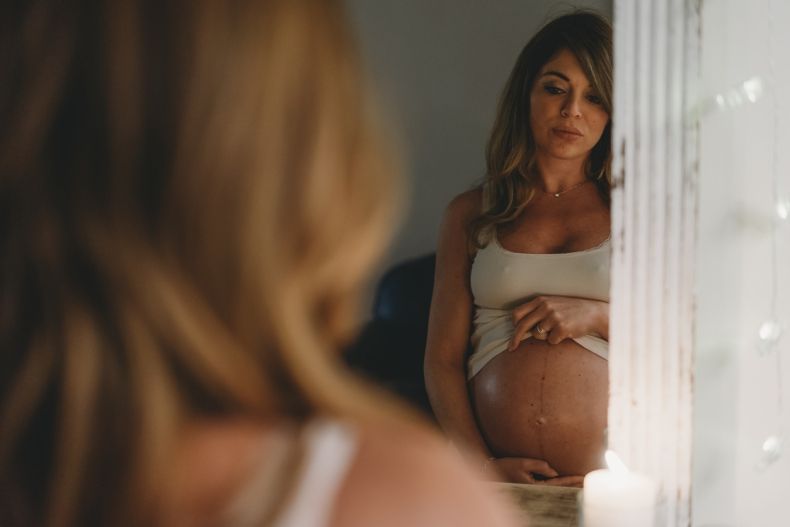 Your sleep position doesn’t need to be top of the list.
Your sleep position doesn’t need to be top of the list.
Doctors recommend resting on your side — right or left — to give you and your baby the optimal blood flow. Beyond that, you might try using some pillow props to get into the most comfortable position for you.
Soak in all the sleep you can before your baby is born. And consult with your doctor if you have other questions about which position is best.
For more pregnancy guidance and weekly tips tailored to your due date, sign up for our I’m Expecting newsletter.
Sleep position in pregnancy Q&A
Tommy's PregnancyHub
In the third trimester of pregnancy going to sleep on your side has been shown to help prevent stillbirth.
In the third trimester our advice is to go sleep on your side because research has shown that this is safer for baby. This includes night sleep and day time naps.
Can I sleep on my back during pregnancy?
Research has shown that in the third trimester (after 28 weeks of pregnancy) going to sleep on your back increases your risk of stillbirth. As the link has now been shown in four separate research trials, our advice is to go to sleep on your side in the third trimester because it is safer for your baby. The advice relates to any episode of sleep, including:
As the link has now been shown in four separate research trials, our advice is to go to sleep on your side in the third trimester because it is safer for your baby. The advice relates to any episode of sleep, including:
- going to sleep at night
- returning to sleep after any night wakenings
- day time naps.
We don’t want you to become anxious about this. If your pregnancy is uncomplicated your risk of stillbirth is low (1 in 200 babies are stillborn). Going to sleep on your side will make it even lower.
How reliable is the research?
The research linking going to sleep on your back to stillbirth is very reliable. Four case control research studies (in which information from women who have had a stillbirth is compared with information from women who have not) have been carried out into maternal sleep position and stillbirth and all have shown that there is a link.
What if I wake up on my back during the night?
The research has been focused on position going to sleep, not position during the night. If you wake up on your back, just settle back to sleep on your side.
If you wake up on your back, just settle back to sleep on your side.
We cannot control our position when we are asleep and a large bump is likely to be uncomfortable enough to prevent you from being on your back for long during the night. We also know that the position we go to sleep in is the position we spend the longest amount of time in during the night.
What could cause the increased risk of stillbirth?
Sleep position in the third trimester is important because if you are on your back the combined weight of baby and womb puts pressure on other organs in your body.
Researchers do not know for certain what exactly is causing the increased risk of stillbirth, but we already know the following, which could play a part :
- When sleeping/lying on your back the baby and womb put pressure on the main blood vessels that supply the uterus and this can restrict blood flow/oxygen to the baby.
- Further recent studies have shown that when a woman lies on her back in late pregnancy (compared to lying on side) the baby is less active and has changes in heart-rate patterns.
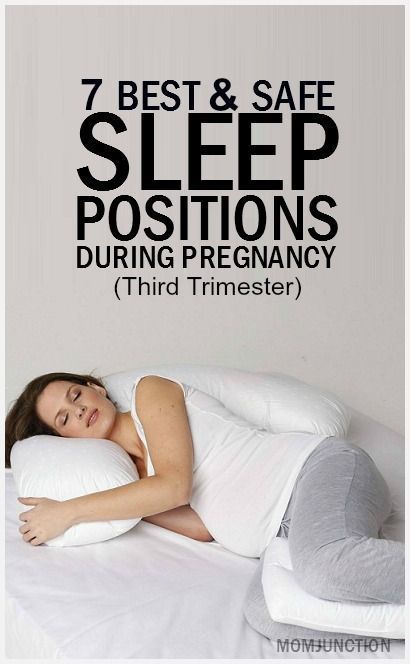 This is thought to be due to lower oxygen levels in the baby when the mother lies on her back.
This is thought to be due to lower oxygen levels in the baby when the mother lies on her back.
Does it make a difference which side I sleep on in pregnancy?
There are many websites that tell you that the left side is best to sleep on during pregnancy. This is for the following reasons:
- One of the smaller research studies, from Auckland, New Zealand, showed that women who sleep on their left side on the last night of pregnancy halved their risk of stillbirth compared to those who slept on their right. However, the same finding has not been seen in any other trial (there have been three other published research studies since then).
- Sleeping on your left has been shown to help your kidneys to get rid of waste products and fluids from your body.
Therefore, while sleeping on your left side has not conclusively been shown to reduce your risk against sleeping on your right, there are reasons that you might choose to do so.
Tips for sleeping on your side in pregnancy
- Put pillows behind you to prevent falling on your back.
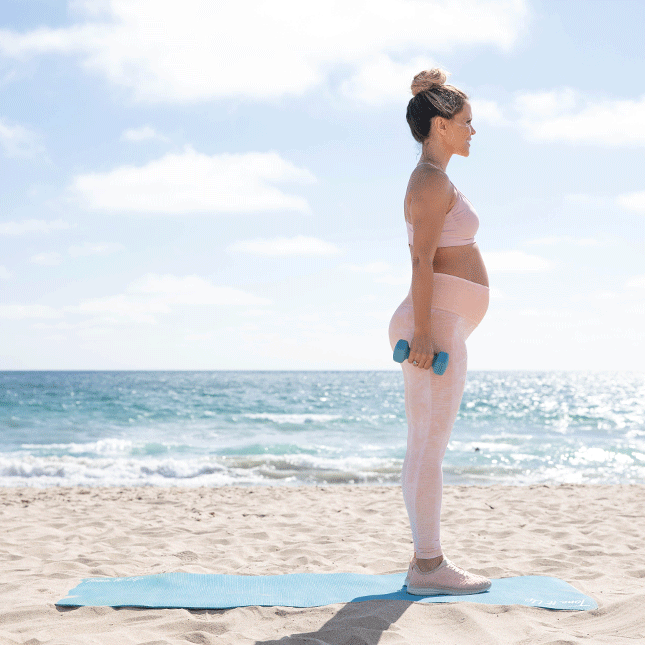 It won’t prevent you being on your back for certain but is likely to make it more uncomfortable.
It won’t prevent you being on your back for certain but is likely to make it more uncomfortable. - If you have long hair, try tying it in a low bun, which may make it uncomfortable to sleep on your back for any length of time.
- If you wake up for any reason during the night, check your position and go back to sleep on your side.
- If you are likely to nap during the day pay the same attention to sleep position during the day as you would during the night.
If you're finding sleeping on your side difficult because of SPD/PGP, try these tips.
In the early days of pregnancy it is fine to sleep on your stomach. Your bump will not start showing until the second trimester and sleeping on your stomach is unlikely to be uncomfortable. In the third trimester, you will have a large bump and it is very unlikely that you would choose this position. However, if you do wake up on your stomach, don’t worry, just roll onto your side.
Heazell AEP, Li M, Budd J, Thompson JMD, Stacey T, Cronin RS, Martin B, Roberts D, Mitchell EA, McCowan LME. Association between maternal sleep practices and late stillbirth – findings from a stillbirth case-control study. BJOG2017; https://doi.org/10.1111/1471-0528.14967.
Association between maternal sleep practices and late stillbirth – findings from a stillbirth case-control study. BJOG2017; https://doi.org/10.1111/1471-0528.14967.
Stacey T1, Thompson JM, Mitchell EA, Ekeroma AJ, Zuccollo JM, McCowan LM.
Association between maternal sleep practices and risk of late stillbirth: a case-control study. BMJ. 2011 Jun 14;342:d3403. doi: 10.1136/bmj.d3403.
Gordon A1, Raynes-Greenow C, Bond D, Morris J, Rawlinson W, Jeffery H. Sleep position, fetal growth restriction, and late-pregnancy stillbirth: the Sydney stillbirth study. Obstet Gynecol. 2015 Feb;125(2):347-55. doi: 10.1097/AOG.0000000000000627.
Lesley ME, McCowan LME, Thompson JMD, Cronin RS et al (2017) Going to sleep in the supine position is a modifiable risk factor for late pregnancy stillbirth; Findings from the New Zealand multicentre stillbirth case-control study. PLOS One https://doi.org/10.1371/journal.pone.0179396
Jeffreys RM, Stepanchak W, Lopez B, Hardis J, Clapp JF, 3rd. Uterine blood flow during supine rest and exercise after 28 weeks of gestation. BJOG : an international journal of obstetrics and gynaecology. 2006 Nov;113(11):1239-47
Uterine blood flow during supine rest and exercise after 28 weeks of gestation. BJOG : an international journal of obstetrics and gynaecology. 2006 Nov;113(11):1239-47
Khatib N, Weiner Z, Beloosesky R, Vitner D, Thaler I. The effect of maternal supine position on umbilical and cerebral blood flow indices. European journal of obstetrics, gynecology, and reproductive biology. 2014 Apr;175:112-4.
Stone PR, Burgess W, McIntyre JP, Gunn AJ, Lear CA, Bennet L, et al. Effect of maternal position on fetal behavioural state and heart rate variability in healthy late gestation pregnancy. The Journal of Physiology. 2017 Feb 15;595(4):1213-21.
Murray I, Hassall J. 2014. Change and adaptation in pregnancy. In: Marshall J, Raynor M. eds. Myles Textbook for Midwives. 16th ed. Edinburgh: Churchill Livingstone, 143-177
Back to top
How to sleep during pregnancy
It is difficult to overestimate the role of sleep in the life of every person. A complete healthy rest allows you to fully restore the functioning of the nervous system, relieve stress, improve performance and increase activity. Chronic sleep deprivation is the cause of many diseases. What can we say about a woman who is at the stage of bearing a baby. During this period, more than ever, she needs a healthy, long and full sleep. However, unfortunately, it is during this period that one can only dream of a restful sleep.
A complete healthy rest allows you to fully restore the functioning of the nervous system, relieve stress, improve performance and increase activity. Chronic sleep deprivation is the cause of many diseases. What can we say about a woman who is at the stage of bearing a baby. During this period, more than ever, she needs a healthy, long and full sleep. However, unfortunately, it is during this period that one can only dream of a restful sleep.
As soon as a woman finds out about her new position, she has to give up a lot for the sake of the health of her unborn baby. And you need to give up not only bad habits: alcohol, cigarettes, coffee, but also from a comfortable sleep.
The cause of insomnia can be :
- Anxiety;
- Frequent urination;
- Fears and phobias before a new stage of one's life;
- Nervousness and irritability;
- Digestive disorder;
- Toxicosis;
- Physical indisposition;
- Uncomfortable posture.
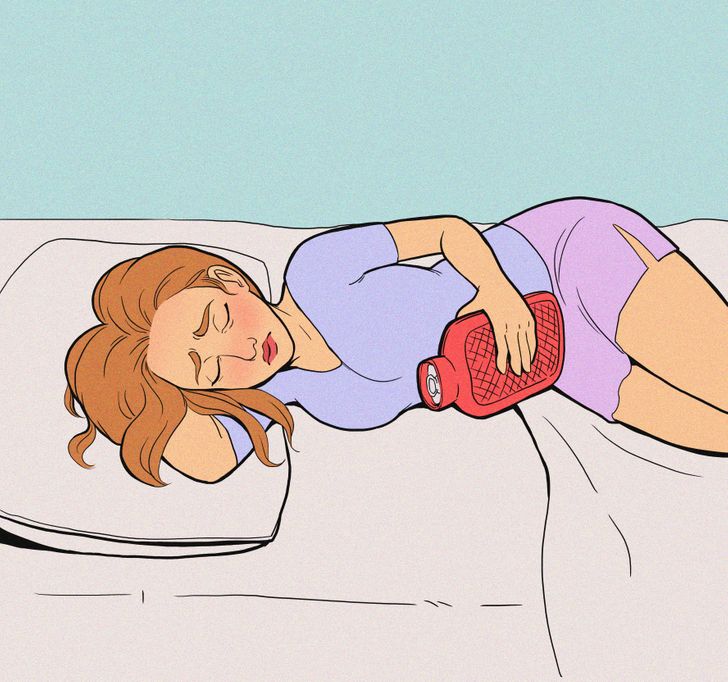
During the period of bearing a child, the female body experiences an extraordinary load, especially in the last trimester. The need for more sleep increases, because the body expends much more energy. Therefore, healthy sleep and pregnancy are inextricably linked.
As soon as a woman finds out about her new position, she has to give up a lot for the sake of the health of her unborn baby. And you need to give up not only bad habits: alcohol, cigarettes, coffee, but also from a comfortable sleep.
Let's try to figure out how to sleep during pregnancy, so as not only not to harm the health of your unborn baby, but to sleep well.
Looking for a comfortable sleeping position
Each person has his own favorite position, in which it is easy to fall asleep and sleep. Many do not imagine a comfortable rest on their backs, accustomed to sleeping on their stomachs. This habit will have to be sacrificed, as it is unsafe for the normal development of the fetus. If in the first three months of pregnancy a woman can still sleep in the position in which she is used to and feels comfortable, then after the first trimester the growing belly will not allow her to lie safely in this position. Despite the natural protection of the baby in the form of amniotic fluid, there is a high probability of injuring the baby in a dream, squeezing it. But what is the right way to sleep during pregnancy?
If in the first three months of pregnancy a woman can still sleep in the position in which she is used to and feels comfortable, then after the first trimester the growing belly will not allow her to lie safely in this position. Despite the natural protection of the baby in the form of amniotic fluid, there is a high probability of injuring the baby in a dream, squeezing it. But what is the right way to sleep during pregnancy?
Back position
Even if you are used to sleeping in a Spartan position, on your back, with your arms spread wide, from the 28th week you will have to radically change your lifestyle. The fact is that as the fetus grows, the load on the intestines and vena cava will increase significantly, blocking the access of oxygen to the baby.
As soon as a woman finds out about her new position, she has to give up a lot for the sake of the health of her unborn baby. And you need to give up not only bad habits: alcohol, cigarettes, coffee, but also from a comfortable sleep.
If you sleep on your back during pregnancy, you may experience the following problems:
- Dizziness;
- Nausea;
- Convulsions;
- Numb limbs;
- Pressure reduction;
- Hemorrhoids;
- Heaviness of breathing.
If you feel these symptoms or the baby gives persistent signals, you need to urgently change your position, so squeezing the vena cava is fraught not only with poor health for the mother, but also with a lack of oxygen supply to the fetus.
Stomach position
One of the most beloved positions for many people, which allows you to quickly fall asleep while hugging a pillow. Many women, as soon as they find out about the change in their lives, are interested in the question, is it possible to sleep on your stomach during pregnancy? Doctors recommend abandoning this position already in the first weeks, even before the enlarged belly makes it impossible to fall asleep peacefully.
If you are afraid during sleep, without controlling your movements, to arbitrarily roll over on your stomach, you can put a large pillow that does not allow you to change position.
Side position
In order to normalize your sleep and not harm the health of the baby, experts recommend sleeping on your side during pregnancy. And if at first this option seems unacceptable to many, after the second trimester, lying on your side is the only possible one. But here the question arises, on which side to sleep in order to ensure the safety of the fetus?
Sleeping on the right side can cause squeezing of the kidney, which can have dire consequences. The ideal posture is lying on the left side. Thus, you not only do not injure the unborn baby, but also improve blood flow along with oxygen to the placenta.
But one should not ignore the individual characteristics of each organism and the position of the fetus in the uterus. When the baby is in a transverse position, choose the side where the baby's head is. And with a breech presentation, doctors recommend changing the position several times a night.
If you still cannot improve your sleep, you feel unwell and you are tormented by insomnia, then it is better to consult a specialist.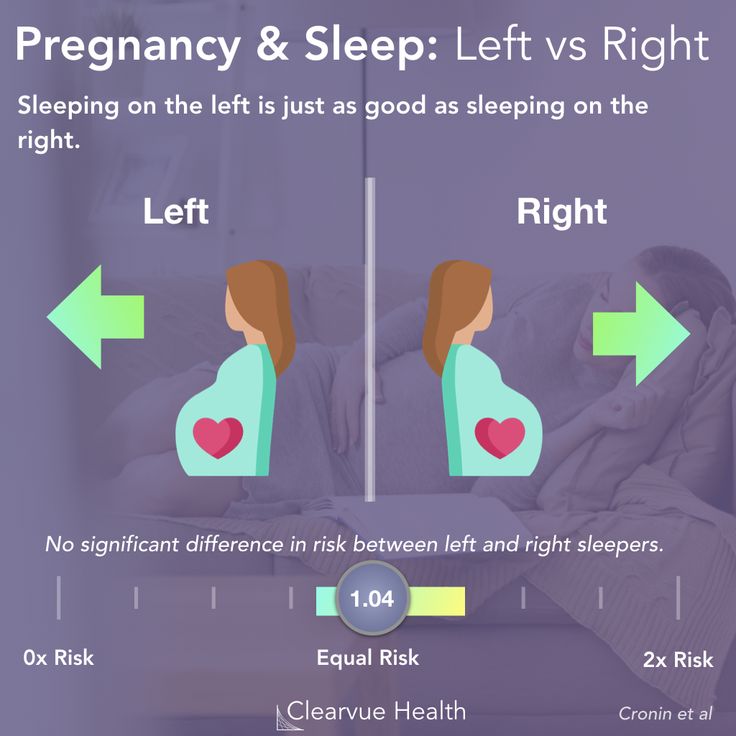 A good gynecologist will analyze the situation and help solve the problem. If necessary, he will prescribe a safe sedative that stabilizes the emotional state and helps to fall asleep calmly, resting and restoring the nervous system in a dream.
A good gynecologist will analyze the situation and help solve the problem. If necessary, he will prescribe a safe sedative that stabilizes the emotional state and helps to fall asleep calmly, resting and restoring the nervous system in a dream.
Help pillow
Fortunately, now modern manufacturers help women survive the pregnancy period with great comfort by offering special pillows. They are made taking into account the physiological characteristics of a woman in this period and allow you to find a comfortable position for relaxation.
You can buy two pillows and put one under your stomach and the other under your knees, looking for your best option. And you can buy a long banana-shaped pillow, which allows you to throw your leg on it while sleeping, which improves well-being and relieves the main load from the lower back and abdomen. Already in the last weeks of pregnancy, when the growing belly does not allow you to breathe normally, the pillow will allow you to take a comfortable half-sitting position.
Remember that pregnancy is your opportunity to gain strength and fully relax before the most crucial period in your life. Childbirth and the first weeks of caring for your baby will require a lot of energy from you, so good luck and sound sleep!
Is it possible to sleep on your stomach during pregnancy
Subscribe to our Instagram! Useful information about pregnancy and childbirth from leading obstetricians and gynecologists in Moscow and foreign experts: https://www.instagram.com/roddompravda/
Tips and opinions from leading child professionals: https://www.instagram.com/emc.child/
Many girls like to sleep on their stomachs, moreover, many of them can fall asleep only in this position. When planning a future pregnancy, many people have reasonable questions about whether it is possible for pregnant women to sleep in this position and for how long can this be done? Obstetrician-gynecologist EMC Olga Panfilova answers these and other questions.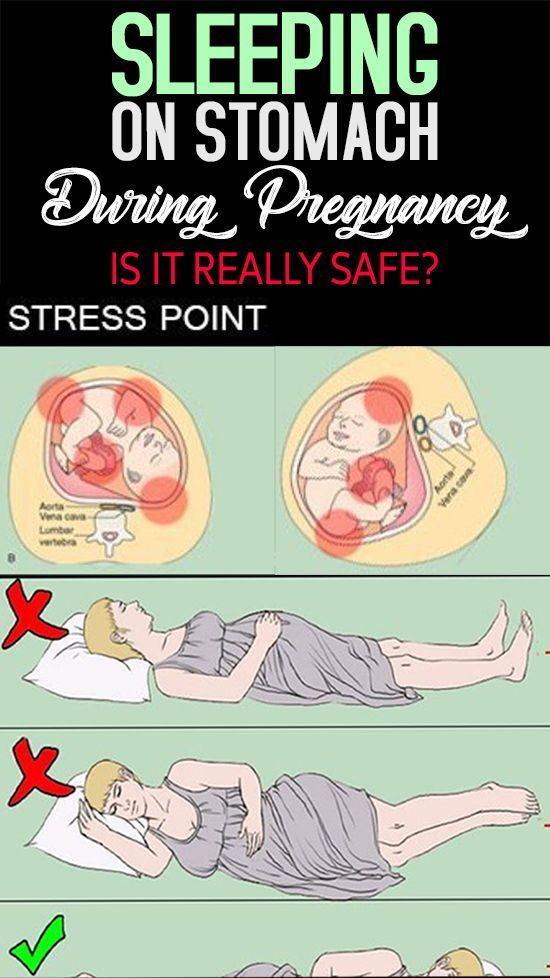
Can I sleep on my stomach in the first trimester?
Of course, for good health and mood, a calm and complete rest at night is very important. This is especially true for a woman who is expecting a baby, because it is she who often has problems with sleep, not least related to the positions that she usually takes in a dream. Including the posture on the stomach. However, in the early stages of pregnancy, you can safely continue to do this. The uterus is still so small and, moreover, so well protected by the bones of the pubis, that this position of the body is not capable of causing any harm to the developing baby. If the usual posture began to cause you discomfort, then most likely this is due to the so-called inflection of the uterus, which occurs due to the fact that the tissues of this organ soften, especially in the isthmus zone. Another cause of inconvenience may be the mammary glands, which begin to gradually increase in size, become painful. If you're having similar problems, it's time to find more comfortable sleeping positions, such as trying to fall asleep lying on your back. And even better already in the early stages to accustom yourself to sleep on your side. You will definitely appreciate the benefits of the newly acquired habit later, when your stomach has reached such a size that even the very thought of trying to sleep on it seems ridiculous.
And even better already in the early stages to accustom yourself to sleep on your side. You will definitely appreciate the benefits of the newly acquired habit later, when your stomach has reached such a size that even the very thought of trying to sleep on it seems ridiculous.
Can I sleep on my stomach in the second trimester?
In the second trimester of pregnancy, the expectant mother can already boast of a voluminous belly, which means that the baby inside has grown up. And even though it is reliably protected by the fetal membranes, amniotic fluid, the muscles of the uterus and the press, laying on the stomach, you still put pressure on the baby. And just imagining that you are lying on your child, you are unlikely to be able to sleep peacefully. At this stage of pregnancy, you can still sleep on your back, but it is best to lie on your side, so you arrange your stomach as comfortably as possible.
Can I sleep on my stomach in the third trimester?
In the third trimester of pregnancy, sleeping on the back of the expectant mother is no longer recommended.